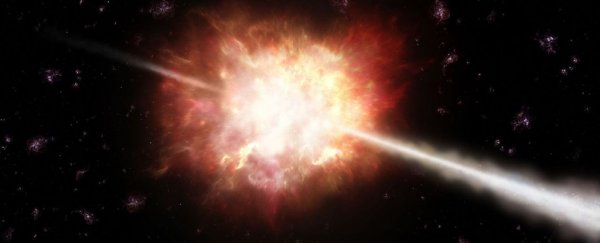Gamma-ray bursts are the brightest and most energetic events in the Universe. They're also some of the more mysterious - but now researchers have made a discovery that could help us understand the conditions under which they occur.
The light curves of six gamma-ray burst events showed evidence of complex time-reversible wavelike structures - that is, there was an event in each pulse in which time seemed to repeat itself backwards.
It could also tell us something about the death of massive stars.
We're not entirely sure what produces gamma-ray bursts. They can last from a few milliseconds to several hours, and they're extraordinarily bright.
We know, thanks to the amazing gravitational wave discovery of colliding neutron stars, that this is one type of event that can produce a gamma-ray burst.
But there are likely others, too. Astronomers think these include the collapse of a rapidly spinning massive star into either a neutron star, a quark star (which is still a hypothetical object) or a black hole, producing a supernova or hypernova in the process.
We can only detect them when the beam is pointed directly at us, and most take place billions of light-years away. This requires some pretty sensitive equipment, often of the optical variety, which means there's a fair bit of noise mixed up with the signal.
That doesn't mean the bursts are difficult to detect - NASA's gamma-ray burst observatory Swift, for instance, which was launched in 2004, had detected 1,000 bursts by late 2015.
But all that noise means that the finer details of the bursts' light curves can be difficult to tease out.
And low instrumental sensitivity, the researchers found, results in a lower resolution signal, "smearing" the structure of a gamma-ray burst pulse light curve.
This results in a triple-peaked appearance for medium bursts, and a single peak for faint ones at low signal-to-noise.
To attempt to minimise this effect, the researchers found six exceptionally bright gamma-ray bursts in the data from the BATSE instrument on NASA's Compton Gamma Ray Observatory, in operation from 1991 to 2000.
This is where they found the complex time-reversible wavelike structures; and, moreover, only the brightest gamma-ray burst light curves had them.
So, what does this actually mean? It could mean that some sort of impactor - a clump of particles like electrons or ions, or a condensed wave such as a soliton - was ejected at high velocity by the central object.
As this impactor moves through the clouds of material previously ejected by the dying star, it produces an emission. If it's partially reflected back through the same clouds, it will produce a similar, but fainter, emission in reverse.
Another explanation is if the clouds of material have some sort of radial bilateral symmetry - like a series of concentric rings - and the impactor moves through them in one direction, without being reflected.
Think of an object moving across a target from one side to the other. The centre of the target is denser clouds than the rings. When the impactor passes through this region, it creates the appearance of a 'reflected signal' - although the researchers aren't sure why.
The research, the team believes, should provide astrophysicists with a new set of tools for understanding stellar death and black hole formation.
"The existence of time-reversed pulse structure leads us to believe that physical models of GRB pulses must contain strong physical symmetries and an interaction with a single impactor," they wrote in their paper.
"We have explored a number of simple kinematic models, and find that either the distribution of impacted material in a [gamma-ray burst] jet must be bilateral-symmetrically distributed and impacted by a single impactor, a physical phenomenon is responsible for reversing the course of a single impactor, or a single impactor creates emission in bilateral-symmetrically distributed material as it passes through it."
The paper will be appearing in The Astrophysical Journal, and is available on preprint resource arXiv.
